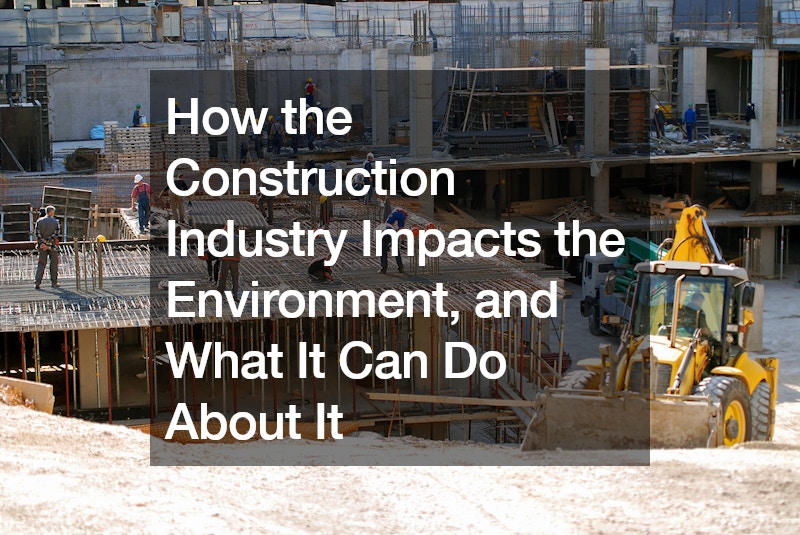The construction industry plays a crucial role in shaping our built environment, yet it also has significant impacts on the natural environment. From water and air pollution to soil erosion, the industry’s activities can have detrimental effects if not managed properly. However, with the right practices and technologies, the construction sector can become more sustainable and reduce its environmental footprint.
Water Contamination
Construction sites are notorious for contaminating water resources. Runoff from concrete washout, wastewater from painting, and spills of oil and other pollutants can degrade water quality.
For instance, the discharge of curing compounds and fuels during equipment operation can introduce harmful substances into nearby water bodies. This contamination can harm aquatic ecosystems, affect drinking water supplies, and disrupt the natural balance of local water sources.
Actionable Steps:
- Implement On-Site Water Treatment: Establish systems such as sedimentation tanks, filtration units, and bio-retention ponds to treat water on-site before it is discharged. These systems can remove suspended solids, oils, and other contaminants, ensuring that only clean water enters the environment.
- Use Eco-Friendly Materials: Opt for non-toxic, biodegradable materials to minimize contamination risks. For example, water-based paints and sealants are less harmful compared to their solvent-based counterparts. Using recycled materials can also reduce the overall environmental footprint of a project.
- Regular Maintenance of Equipment: Ensure that machinery is well-maintained to prevent leaks and spills. Regular inspections and maintenance schedules can help identify potential issues before they lead to environmental damage. Using drip pans and spill kits on-site can quickly address any leaks that do occur.
- Innovative Practices: Integrate innovative practices such as rainwater harvesting and greywater recycling to reduce the demand on freshwater sources. Using permeable paving materials can help manage stormwater runoff by allowing water to seep into the ground, reducing the risk of pollution.
Air Pollution
The construction industry contributes significantly to air pollution through the emission of greenhouse gases such as carbon dioxide. These emissions primarily come from the heavy use of vehicles and equipment, which burn fossil fuels and release harmful pollutants into the atmosphere. Additionally, deforestation for construction purposes reduces the number of trees that can absorb CO2 and produce oxygen, exacerbating air quality issues. This not only impacts local air quality but also contributes to global climate change, affecting ecosystems and human health.
Actionable Steps:
- Adopt Electric and Hybrid Machinery: Use electric or hybrid vehicles and equipment to reduce emissions. These machines produce fewer greenhouse gases and are quieter, reducing noise pollution. Investing in renewable energy sources, such as solar or wind power, to charge electric machinery can further minimize the carbon footprint.
- Reforestation Projects: Engage in reforestation efforts to replace trees removed during construction. Planting native trees and vegetation can help restore ecosystems, enhance biodiversity, and improve air quality by absorbing CO2. Partnering with local communities and environmental organizations can ensure these projects are sustainable and effective.
- Monitor Emissions: Utilize construction management software to track and manage emissions from construction activities. This software can provide real-time data on fuel consumption, machinery usage, and emissions, helping project managers identify areas for improvement. Implementing emissions reduction plans and setting specific targets can drive continuous improvement.
- Innovative Solutions: Implement green building practices, such as using low-emission construction materials and incorporating energy-efficient designs. Adopting prefabrication and modular construction techniques can also reduce the time and emissions associated with on-site construction activities.
Soil Erosion and Contamination
Construction activities can lead to severe soil erosion and contamination. Runoff containing concrete washout and other pollutants can degrade soil quality. Moreover, the operation of heavy machinery can lead to oil spills, further contaminating the soil.
Actionable Steps:
- Erosion Control Measures: Implement silt fences, sediment basins, and other erosion control measures to prevent soil degradation.
- Spill Prevention Plans: Develop and enforce strict spill prevention and response plans to mitigate soil contamination.
- Use Sustainable Landscaping: Incorporate sustainable landscaping techniques that protect soil integrity.
Leveraging Technology
Modern technology, including construction management software, plays a vital role in promoting sustainability. These tools can help manage resources more efficiently, track environmental impacts, and ensure compliance with environmental regulations. By leveraging technology, construction projects can minimize waste, reduce emissions, and enhance overall sustainability.
Actionable Steps:
- Integrate Construction Management Software: Use software to optimize resource allocation, track emissions, and ensure sustainable practices are followed. These platforms can manage project timelines, monitor material usage, and provide insights into resource efficiency, helping to reduce waste and lower the carbon footprint.
- Data Analytics: Employ data analytics to identify areas where environmental impact can be reduced. Analyzing data from various project stages can highlight inefficiencies, predict potential environmental issues, and suggest corrective measures. For instance, predictive analytics can forecast material needs accurately, reducing excess ordering and waste.
- Training and Education: Use technology to provide ongoing training and education to workers on sustainable practices. Online modules, virtual reality simulations, and mobile apps can deliver interactive and up-to-date training on environmental regulations, waste management, and energy-efficient practices. This continuous education ensures that all team members are knowledgeable about and committed to sustainability.
- Innovative Solutions: Implement innovative solutions such as Building Information Modeling (BIM) to enhance project planning and design. BIM can simulate construction processes, identify potential environmental impacts, and suggest sustainable alternatives before actual construction begins. Additionally, utilizing drones and IoT devices can monitor site conditions in real-time, ensuring immediate corrective actions to minimize environmental harm.
Conclusion
The construction industry’s environmental impact is significant, but with targeted actions and the integration of advanced technologies, it can become more sustainable. By focusing on water and air quality, soil integrity, waste reduction, and leveraging construction management software, the industry can mitigate its environmental footprint and contribute to a healthier planet. It’s crucial for all stakeholders in the construction sector to commit to these sustainable practices to ensure a balance between development and environmental stewardship.
.


